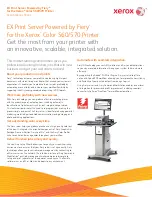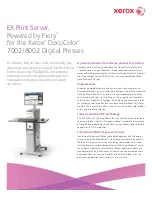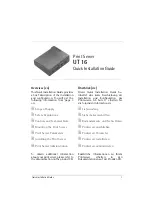
136 | Discovering, Adding, and Managing Devices
Dell PowerConnect W-AirWave 7.6 | User Guide
Setting
Default
Device Type
Description
Mesh Role
Mesh AP
Mesh Devices
Drop-down menu specifies the mesh role for the AP as shown:
l
Mesh AP
—The AP will act like a mesh client. It will use other
APs as its uplink to the network.
l
Portal AP
—The AP will become a portal AP. It will use a
wired connection as its uplink to the network and serve it over
the radio to other APs.
l
None
—The AP will act like a standard AP. It will not perform
meshing functions.
Mesh Mobility
Static
Mesh Devices
Select
Static
if the AP is static, as in the case of a device mounted
on a light pole or in the ceiling. Select
Roaming
if the AP is
mobile. Two examples would be an AP mounted in a police car or
utility truck.
Receive
Antenna
Diversity
Cisco
Drop-down menu for the receive antenna provides three options:
Diversity
—Device will use the antenna that receives the best
signal. If the device has two fixed (non-removable) antennas, the
Diversity
setting should be used for both receive and transmit
antennas.
Right
—If your device has removable antennas and you install a
high-gain antenna on the device's right connector (the connector
on the right side when viewing the back panel of the device), use
this setting for receive and transmit.
Left
—If your device has removable antennas and you install a
high-gain antenna on the device's left connector, use this setting
for both receive and transmit.
Transmit
Antenna
Diversity
Cisco
See description in
Receive Antenna
above.
Antenna
Diversity
Primary Only
Symbol 4131
Drop-down menu provides the following options:
Full Diversity
—The AP receives information on the antenna with
the best signal strength and quality. The AP transmits on the
antenna from which it last received information.
Primary Only
—The AP transmits and receives on the primary
antenna only. Secondary Only: The AP transmits and receives on
the secondary antenna only.
Rx Diversity
—The AP receives information on the antenna with the
best signal strength and quality. The AP transmits information on
the primary antenna only.
Transmit Power
Reduction
0
Proxim
Transmit Power Reduction determines the APs transmit power.
The max transmit power is reduced by the number of decibels
specified.
Channel
6
All
Represents the AP’s current RF channel setting. The number
relates to the center frequency output by the AP’s RF synthesizer.
Contiguous APs should be set to different channels to minimize
‘crosstalk,’ which occurs when the signals from APs overlap and
interfere with each other. This RF interference negatively
influences WLAN performance.
802.11b’s 2.4-GHz range has a total bandwidth of 80-MHz, separated
into 11 center channels. Of these channels, only 3 are non-
overlapping (1, 6, and 11). In the United States, most organizations
use only these non-overlapping channels.
Table 82:
APs/Devices > Manage, Additional Settings
Summary of Contents for PowerConnect W-AirWave 7.6
Page 1: ...Dell PowerConnect W AirWave 7 6 User Guide ...
Page 12: ...xii Dell PowerConnect W AirWave 7 6 User Guide ...
Page 112: ...100 Configuring and Using Device Groups Dell PowerConnect W AirWave 7 6 User Guide ...
Page 162: ...150 Discovering Adding and Managing Devices Dell PowerConnect W AirWave 7 6 User Guide ...
Page 198: ...186 Using RAPIDS and Rogue Classification Dell PowerConnect W AirWave 7 6 User Guide ...
Page 276: ...264 Creating Running and Emailing Reports Dell PowerConnect W AirWave 7 6 User Guide ...
Page 324: ...312 Using VisualRF Dell PowerConnect W AirWave 7 6 User Guide ...
Page 332: ...320 Index Dell PowerConnect W AirWave 7 6 User Guide ...
















































